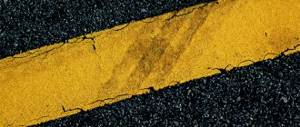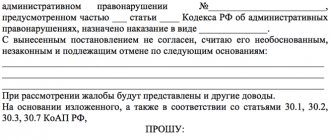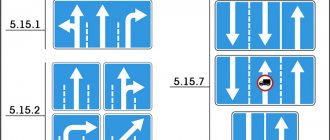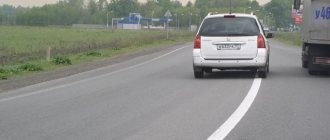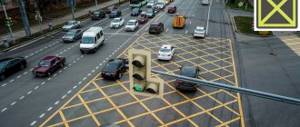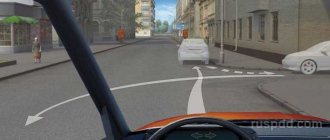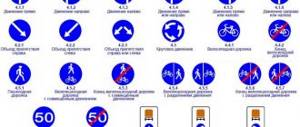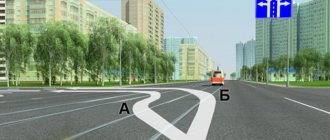Young drivers often have many questions that somehow never even occurred to them before, when their whole life was spent on two legs. One of the most common - what is the difference between a single dividing strip and a double solid one?
Concept of double and single solid lines
Some drivers face questions about the median lines. Even after completing the courses and having learned all the rules, car enthusiasts do not fully understand the difference between the two concepts. The problem lies in the minimum amount of time allocated for this topic.
Note the difference between the two restrictions:
- Single line - used for marking roads and highways where there are only two lanes for multi-directional traffic (one in each direction).
- Double line – used on wide highways and city roads with four or more lanes. In most cases, such lines can be found on country roads and wide city roads, which provide several oncoming and passing lanes.
Wide highways with several oncoming lanes can significantly increase the space for overtaking, detours and other maneuvers.
This is interesting: 3 violations for which inspectors often punish more severely than expected
Punishment
Quite surprisingly, there is no rule in the Code of Administrative Offenses of the Russian Federation prohibiting crossing a double solid line. No, this does not mean that such a violation will not be punished, it means that this rule has a different wording, namely: driving into oncoming traffic. This wording also stipulates that the violation report drawn up by the inspector will also not indicate the fact of intersection, while the severity of the violation, taking into account all other conditions, may be the same for both double and single lanes.
IMPORTANT !!! Punishment for such a violation can be either a fine or deprivation of the right to drive a vehicle. Such a decision can be appealed within ten days from the date of the decision.
And the size of the fine may vary depending on related factors, that is: whether the driver drove around a stationary structure on the road, whether he overtook a slow-moving vehicle, whether this vehicle was equipped with an appropriate sign, what are the consequences of such a maneuver, and so on.
When to use single markup
One of the variations of road markings is single marking, or single solid line, or 1.1 marking.
Single markings are placed not on the edge of the roadway, but exclusively inside it.
Markup 1.1. used in four variants:
For the purpose of marking traffic lanes on roads with several lanes in both directions (two or three)
A single solid line separates two-lane and three-lane roads to separate traffic flows in different directions.
On a three-lane road, such markings also prohibit driving into oncoming traffic and indicate that you should only move in your own lane.
In addition, single markings are drawn on dangerous sections of the road:
- sharp turns when visibility is limited;
- approaching intersections, railroad crossings, pedestrian crossings, or bicycle paths;
- with a lane for minibuses or taxis when access to it is prohibited.
A single line is placed to indicate traffic on a road with 2 and 3 lanes in the same direction
Another quite common case of using a single solid line is when it is applied to a road with a large number of stripes to designate a lane of traffic in a single direction. At the same time, vehicles are prohibited from changing from one lane to another when it is unsafe to do so.
Also, the need for markings 1.1 arises when indicating dangerous sections of the road.
Marking 1.1 for marking parking areas
Such a line is placed on special sites that are intended for parking one vehicle, as well as in parking lots near the sidewalk.
In this case, the markings highlight the very “framework” within which you need to park your car. The driver must follow the parking rules and not leave the car across the designated parking space.
Otherwise, he will grossly violate the rules and, at best, an administrative penalty will be imposed on him.
“Single continuous” for areas where entry is prohibited
A single line is also used in very specific situations: to limit a safe island, a directional island, and other situations if there is a need to prohibit entry to such areas.
When is only a fine imposed?
Financial liability is provided if the driver:
- Made a turn or turn. The amount of the fine does not exceed 1,500 rubles;
- I drove into the oncoming lane. This is punishable by a fine of 5,000 rubles, but not in every case;
- I drove around an obstacle and at the same time crossed a solid marking. Punishment is provided in the amount of 1,000 to 1,500 rubles;
- I left the yard and turned left, crossing a double lane. The fine is 500 rubles;
- Crossed solid markings at an intersection. The fine amount is 1,500 rubles:
- Completed a previously started (in an authorized location) maneuver. The fine reaches 5,000 rubles, but not in every case;
- I crossed the markings, changing lanes into the second row. The amount of punishment is 1,500 rubles.
Overtaking by crossing a double solid line
From the point of view of the Administrative Code, is there a difference in the number of marking lines
There is practically no significant difference between single solid and double. Markings 1.1 are drawn on roads with no more than 2 lanes, and markings 1.3 on roads with several lanes in both directions.
Crossing a double marking line does not mean that the penalty will be double the fine. In the traffic rules there is no such concept as “crossing a single or double continuous marking line”, there is only “entering the lane of oncoming traffic.” That is, crossing a single or double solid line indicates entering the oncoming lane.
It is strictly forbidden to cross both of these markings. Even if you want to make a maneuver such as overtaking or you need to go around an obstacle.
For such a violation, the driver is punished with a fine of five thousand rubles or deprivation of the right to drive a vehicle for a period of 4 to 6 months. If the violation is repeated, the deprivation will be for a year.
When making a U-turn or turning, crossing a single solid or double solid line, it is punishable by a fine of 1 thousand to 1.5 thousand rubles.
Turning, turning around and entering the oncoming lane is allowed only if the solid line has turned into a broken line, and if we are talking about a double solid line, but the dotted line should be on your side of the road.
All landmark lines on roads are invented and written down for a reason. In no case should they be ignored, and every driver, pedestrian or cyclist should know what they mean and how to behave in a given situation, then everyone will be able to protect themselves and other people from road accidents and reduce the risk of an accident.
Double continuous - types of violation of this marking
Common driver mistakes for which they may face a fine when crossing a double solid line include:
- A turn or turn with the intersection of markings in the same direction;
- Drifting into the oncoming lane. This can happen when the driver decides to overtake the car ahead or turns left, driving into oncoming traffic;
- Avoiding an obstacle by crossing a double solid line;
- Departure from the local area by turning left and crossing the road markings;
- Changing lanes at an intersection with continuous markings;
- Completion of a maneuver begun on an intermittent strip;
- Changing to the second row.
Crossing a double solid line is punishable
Purpose of different types of markup
In order to understand, you need to understand in which cases one continuous line is applied to the road surface, and in which – two. Both types of lines are regulated by Appendix 2 to the Traffic Regulations. The first markup option is numbered 1.1, and the second is numbered 1.3.
A single solid line (1.1) is designed to separate traffic flows moving in opposite directions. In addition, it marks the boundaries of lanes in dangerous sections of the roadway, as well as the edge of the roadway and parking spaces.
Double continuous markings (1.3), like single ones, serve to separate traffic flows moving in opposite directions. It is only used mainly on roads with four or more lanes. Marking 1.3 is applied to a two- or three-strip fabric if the width of the stripes exceeds 3.75 m.
So we see that the basic function of these two types of lines is the same. Exactly what marking will be applied depends only on the number of stripes and their width.
What is the penalty for crossing a solid line?
Let us remind you once again that a violation, and, therefore, a punishment for it, will be either the fact of crossing a solid line, or the action arising from such an intersection. These offenses are outlined in the Administrative Legislation.
The approach to determining the penalty can be defined as follows: if a case that constitutes a violation is separately indicated in the Code of Administrative Offences, the norms of such instructions are applied, in other cases - the norms of Part 1 of Article 12.16 of the Code of Administrative Offenses of the Russian Federation - failure to comply with the requirements of signs and markings, implying a fine of 500 rubles
Hitting a continuous median
This is the case already discussed above. Here we mention again that any contact with a solid line will be counted as its intersection. The penalty for hitting or driving over will be the same as for leaving the entire body of the vehicle outside the line. It doesn’t matter if one or two lines intersect - both cases are not allowed.
Intersection solid
Now let's look at the most common and most frequently questioned cases.
Entering oncoming traffic
The very fact of driving into oncoming traffic is always a violation, and one of the serious ones. However, not every case where a car ends up in the lane intended for oncoming traffic is “driving into oncoming traffic.”
Here are some of the most common cases:
- Double solid . Let us remind you that it is used to separate traffic on roads with 4 or more lanes. On such roads, overtaking is prohibited in any case, which means each of them will be interpreted as driving into the oncoming lane, which means for the first violation a fine of 5,000 rubles or deprivation of rights for 4 - 6 months. If repeated, imprisonment for a year. The exception is camera recording. In this case, only a fine of 5,000 rubles is possible (Part 4 and Part 5 of Article 12.15 of the Code of Administrative Offenses of the Russian Federation).
- Overtaking through a single continuous lane . We are talking specifically about overtaking, and in cases where such a violation is interpreted as driving into oncoming traffic, the punishment will be the same as for the above-mentioned intersection of two lines. However, some cases of overtaking may be assessed differently - we discussed all the details in this article.
- Avoiding obstacles . This type of maneuver, if accompanied by crossing a continuous line, is also a violation. However, the punishment for it is specified in a separate norm. In accordance with Part 3 of Article 12.15 of the Administrative Code of Russia, this is a fine of 1000 to 1500 rubles.
- Rotate / U-turn . These solid line maneuvers represent the widest range of violations. In practice, the situation may include all the cases under consideration from a simple violation of the marking (500 rubles under Part 1 of Article 12.16) to deprivation of rights for a year under Part 5 of Article 12.15, depending on the circumstances of the incident. We discussed this topic in detail in the article about turning or turning through a solid line.
It is obvious that the considered cases can overlap, excluding one another, or, conversely, forming several compositions at once.
Driving into oncoming traffic when overtaking quickly
Prohibited by current legal regulations. The choice of the applied sanction depends on the circumstances of the illegal actions committed. If the driver of the vehicle overtook another car or an obstacle on the road, ignoring the indications of the road markings, the fine amount will be 1-1.5 thousand rubles.
In other cases, such a maneuver may result in a monetary penalty in the amount of 5 thousand rubles for the offender. or confiscation of the driver's license for up to six months. The minimum period of time for which a driver is suspended from driving a motor vehicle is four months.
So, for example, overtaking “in the oncoming lane” of another vehicle moving at a relatively low speed is punishable by a fine of up to 1.5 thousand rubles. In such situations, it is better not to take risks, even if the slow-moving vehicle in front is moving at a minimum speed. According to the Rules, a driver who creates an obstacle to the movement of other vehicles is subject to punishment. And if after the first such violation a person can get off with a monetary penalty, then if the traffic police officers record a similar illegal action again, a more severe punishment will follow.
In addition, one should distinguish between concepts such as “overtaking” and “overcoming an obstacle.” Often, drivers regard a bus that has stopped at the exit (boarding) point for passengers as an obstacle impeding movement. Therefore, they often detour the bus in violation of the marking requirements on the road surface, namely: crossing a solid line and entering the adjacent lane of oncoming traffic.
This interpretation of the law may cost the driver his license. Depending on the circumstances and severity of the offense committed, the driver becomes a pedestrian for a period of four to six months.
Is it possible to lose your license for crossing?
Actions for which you can lose the right to drive a car are described in Art. 12.15 Code of Administrative Offenses (Part 4). According to Resolution of the Plenum of the Armed Forces of the Russian Federation No. 18, clause 8, deprivation of rights (the alternative is payment of a fine of 5,000 rubles) is possible in the following cases:
- if the driver entered the oncoming lane on roads with 3 lanes, when the middle lane is used for traffic in both directions;
- if a person driving a car decides to pass oncoming traffic in front of a railway crossing.
- traveling onto oncoming tram tracks;
- a turn after which the car will be in the oncoming lane;
- overtaking on dangerous sections of the road (at intersections, railway crossings, pedestrian crossings, on bridges, inclines, etc.), where different traffic flows are separated by markings 1.1.
